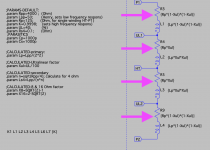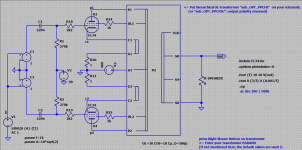I want to share an LTspice hierarchical circuit I made for an ultralinear push-pull output transformer. The zip file contains two working examples (Mullard 5-10 and 5-20). Put 'sub_opt_pp.asc' and 'sub_opt_pp.asy' in the same directory as your amplifier schematic. Then change the PARAMS to match the specs of your transformer. Please let me know if you find an error, or a better way to model the parasitics.
PP UL-transformer in post 9
SE transformer in post 15
CFB transformer in post 16.
Hammond 125A in post 26
Leak-8615 in post 28
SE transformer with non-linear Chan core in post 38
Ite
PP UL-transformer in post 9
SE transformer in post 15
CFB transformer in post 16.
Hammond 125A in post 26
Leak-8615 in post 28
SE transformer with non-linear Chan core in post 38
Ite
Last edited:
This is great Ite! Thank you so much 🙂
I am trying to use it to simulate a Triad HSM-186, which has 6600k/1220k split primary with a centre tap, and 16, 8 and 4 Ohm secondaries. The total inductance is about 100H.
I am trying to use it to simulate a Triad HSM-186, which has 6600k/1220k split primary with a centre tap, and 16, 8 and 4 Ohm secondaries. The total inductance is about 100H.
Thanks, I will try it as soon as I get a chance. Any improvements in transformer modeling great and essential to predictive design and sorely needed from my perspective.
@Boyfarrel,
You spotted a mistake, thanks!
The resistors R3 and R9 should indeed be proportional to (1-Xul), and NOT to (1-Xul)^2.
I will try to upload an improved version later.
@Potentialyincorrect
The modeling of the transformer is not different from the usual practice. The hierarchical approach just makes it a lot easier. Just put the transformer on your schematic, put in the numbers you can want, or numbers you measured from a real transformer. No need to put a bunch of coupled inductors with odd values you have to calculate on the schematic anymore.
You spotted a mistake, thanks!
The resistors R3 and R9 should indeed be proportional to (1-Xul), and NOT to (1-Xul)^2.
I will try to upload an improved version later.
@Potentialyincorrect
The modeling of the transformer is not different from the usual practice. The hierarchical approach just makes it a lot easier. Just put the transformer on your schematic, put in the numbers you can want, or numbers you measured from a real transformer. No need to put a bunch of coupled inductors with odd values you have to calculate on the schematic anymore.
Thanks @Ite! I included the model in a circuit I am debugging. But I will make a fresh circuit and get the output transformer working by itself. Thanks for the tip.
Updated! Thanks.
In your Mullard circuits I see a really nice feature in LTSpice that I didn't know existed. How did you get LTSpice to display the DC voltage at various points in the circuit? (I am using LTSpice on macOS so maybe it is a feature I don't see in UI)
In your Mullard circuits I see a really nice feature in LTSpice that I didn't know existed. How did you get LTSpice to display the DC voltage at various points in the circuit? (I am using LTSpice on macOS so maybe it is a feature I don't see in UI)
run a transient analysis.
hoover with the cursor over a signal till you see the oscilloscoop probe.
press RightMouseButton
choose [88 place .op Data Label]
formatting:
RightMouseButton on the label
change $ to
- round($*10)/10 for 1 digits
- round($*100)/100 for 2 digits etc
hoover with the cursor over a signal till you see the oscilloscoop probe.
press RightMouseButton
choose [88 place .op Data Label]
formatting:
RightMouseButton on the label
change $ to
- round($*10)/10 for 1 digits
- round($*100)/100 for 2 digits etc
Thanks! I can now add labels but not format them, but that is a macOS version issue, sadly, Formatting .op Data Labels in LTspice for Mac - Page 2 My laptop is too old for virtual machines too, otherwise would run Linux.
Hi Lte,
I missed the updated to this nice transformer model. It is now in my LTSpice "tool kit" I use it whenever I need a transformer.
Dan
I missed the updated to this nice transformer model. It is now in my LTSpice "tool kit" I use it whenever I need a transformer.
Dan
One question.
In which way is possible to have a model of a OT when each one of them has a proper parasitic that is not similar to the thousands of others?
For a low and high frequency; in the middle we can arrange ( less or more)
I mean about manifacturer, Z, dimensions, topology, etc
So I have to design a circuit then I simulate it, maybe it will run, but it is out of the real world, at the end.
Walter
In which way is possible to have a model of a OT when each one of them has a proper parasitic that is not similar to the thousands of others?
For a low and high frequency; in the middle we can arrange ( less or more)
I mean about manifacturer, Z, dimensions, topology, etc
So I have to design a circuit then I simulate it, maybe it will run, but it is out of the real world, at the end.
Walter
Hi Walter,
You are clearly a spice skeptic.
Spice is always an approximation of reality. The results of simulations are as good as the models. The tubes models are not perfect either, but close enough. Same for transformer models .
A lot of people use spice to model there amplifier as a first step before building it. Even if the models are not 100% correct, it can give valueable insight in your circuit.
My transformer model uses the hierarchical feature of LTspice that makes it so much easier to model a transformer. Just enter a few parameters from the transformer spec-sheet (Impedance, inductance, resistance, K-factor (depends on leackage inductance), parasitic capacitance and you're ready to go.
With spice you can perform experiments like: what happens if UL not 43% but 30%. Or what happens if I use a 4300 Ohm transformer instead of a 3500 Ohm one. With the hierarchical model just change a parameter from UL=43 to UL=30 etc.
conclusion: a model is not perfect, but most of the time good enough. Nothing prevents you from measuring your transformer and adapting the model to give a better fit. Perhaps someone with experience in this area can improve the transformer model?
Ite
cumbersome old-school transformer modeling from the time that LTspice did't support hierarchical models:
http://www.diyaudio.com/forums/tubes-valves/181578-spice-transformer-model-spreadsheet.html
You are clearly a spice skeptic.
Spice is always an approximation of reality. The results of simulations are as good as the models. The tubes models are not perfect either, but close enough. Same for transformer models .
A lot of people use spice to model there amplifier as a first step before building it. Even if the models are not 100% correct, it can give valueable insight in your circuit.
My transformer model uses the hierarchical feature of LTspice that makes it so much easier to model a transformer. Just enter a few parameters from the transformer spec-sheet (Impedance, inductance, resistance, K-factor (depends on leackage inductance), parasitic capacitance and you're ready to go.
With spice you can perform experiments like: what happens if UL not 43% but 30%. Or what happens if I use a 4300 Ohm transformer instead of a 3500 Ohm one. With the hierarchical model just change a parameter from UL=43 to UL=30 etc.
conclusion: a model is not perfect, but most of the time good enough. Nothing prevents you from measuring your transformer and adapting the model to give a better fit. Perhaps someone with experience in this area can improve the transformer model?
Ite
cumbersome old-school transformer modeling from the time that LTspice did't support hierarchical models:
http://www.diyaudio.com/forums/tubes-valves/181578-spice-transformer-model-spreadsheet.html
- Home
- Amplifiers
- Tubes / Valves
- LTspice hierarchical ultralinear OPT


